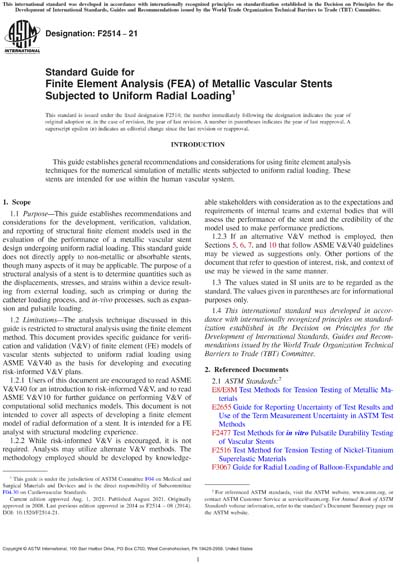Most recent
ASTM F2514-21
Standard Guide for Finite Element Analysis (FEA) of Metallic Vascular Stents Subjected to Uniform Radial Loading
1.1Purpose - This guide establishes recommendations and considerations for the development, verification, validation, and reporting of structural finite element models used in the evaluation of the performance of a metallic vascular stent design undergoing uniform radial loading. This standard guide does not directly apply to non-metallic or absorbable stents, though many aspects of it may be applicable. The purpose of a structural analysis of a stent is to determine quantities such as the displacements, stresses, and strains within a device resulting from external loading, such as crimping or during the catheter loading process, and in-vivo processes, such as expansion and pulsatile loading.
1.2Limitations - The analysis technique discussed in this guide is restricted to structural analysis using the finite element method. This document provides specific guidance for verification and validation (V&V) of finite element (FE) models of vascular stents subjected to uniform radial loading using ASME V&V40 as the basis for developing and executing risk-informed V&V plans.
1.2.1Users of this document are encouraged to read ASME V&V40 for an introduction to risk-informed V&V, and to read ASME V&V10 for further guidance on performing V&V of computational solid mechanics models. This document is not intended to cover all aspects of developing a finite element model of radial deformation of a stent. It is intended for a FE analyst with structural modeling experience.
1.2.2While risk-informed V&V is encouraged, it is not required. Analysts may utilize alternate V&V methods. The methodology employed should be developed by knowledgeable stakeholders with consideration as to the expectations and requirements of internal teams and external bodies that will assess the performance of the stent and the credibility of the model used to make performance predictions.
1.2.3If an alternative V&V method is employed, then Sections 5, 6, 7, and 10 that follow ASME V&V40 guidelines may be viewed as suggestions only. Other portions of the document that refer to question of interest, risk, and context of use may be viewed in the same manner.
1.3The values stated in SI units are to be regarded as the standard. The values given in parentheses are for informational purposes only.
1.4This international standard was developed in accordance with internationally recognized principles on standardization established in the Decision on Principles for the Development of International Standards, Guides and Recommendations issued by the World Trade Organization Technical Barriers to Trade (TBT) Committee.
Content Provider
ASTM International [astm]






